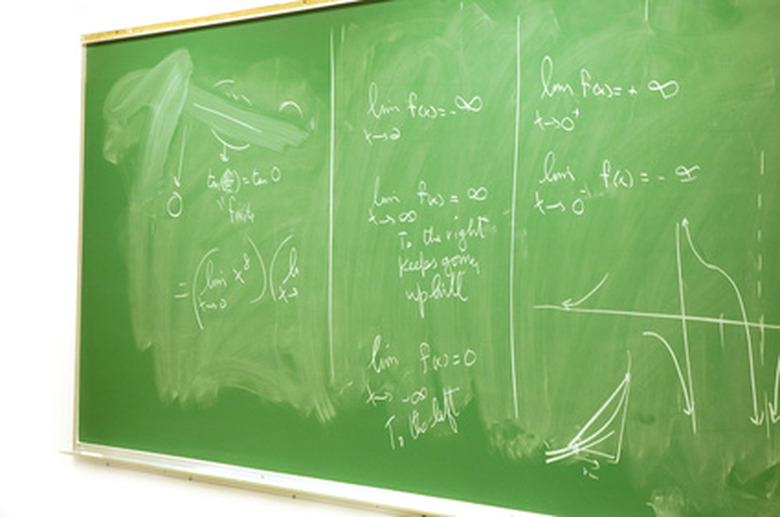What Is Delta In Math?
As mathematics developed over the course of history, mathematicians needed more symbols to represent the numbers, functions, sets, and equations that were coming to light. Because most scholars had some understanding of Greek, the letters of the ancient Greek alphabet were an easy choice for these symbols. The Greek letter delta is the fourth letter in the Greek alphabet. Depending on the branch of mathematics or science, delta means very different things.
Change
Change
Upper-case delta (Δ) often signifies "change" in mathematics. For example, if the variable x stands for the movement of an object, then Δx (delta x) means "the change in movement." Scientists use this mathematical meaning of delta often in physics, chemistry, and engineering, and it appears often in word problems. It often be used to signify a rate of change in combination with a time interval. This might also be represented as a fraction to display a ratio of changes:
\(\frac{x_2-x_1}{y_2-y_1} = \frac{\Delta x}{\Delta y}\)
TL;DR (Too Long; Didn't Read)
Delta can be applied to any variety of variables. Δ_y_ (delta _y_) is just as valid as Δ_q_ (delta _q_); it just depends on the measurement.
Uncertainty
Uncertainty
In error analysis, the lower-case delta (δ) can represent the uncertainty or error in a measurement. It will often be paired with the variable that the error modifies. For example, if you are measuring the the time (t) of a process, with uncertainty, you might report it as:
\(\text{Time Measure } = t \ \pm \ \delta t\)
Discriminant
Discriminant
In Algebra, upper-case delta (Δ) often represents the discriminant of a polynomial equation, usually the quadratic equation. Given the quadratic ax² + bx + c, for example, the discriminant of that equation will equal b² – 4ac, and it will look like this:
\(\Delta = b^2-4ac\)
A discriminant gives information about the quadratic's roots: depending on the value of Δ, a quadratic may have two real roots, one real root, or two complex roots.
Angles
Angles
In geometry, lower-case delta (δ) may represent an angle in any geometric shape. This is because geometry has its roots in the work of Euclid in ancient Greece, and mathematicians then marked their angles with Greek letters. Because the letters simply represent angles, knowledge of the Greek alphabet and its order isn't necessary to understand their significance in this context.
Other Uses
Other Uses
Lower-case delta (δ) also has more specific functions in advanced mathematics. The Kronecker delta, for example, represents a relationship between two variables, which is 1 if the two variables are equal, and 0 if they are not. Most students of mathematics won't have to worry about these meanings for delta until their studies are very advanced. Another type of function that uses δ is the Dirac delta function, which is a linear equation (function) that very generally maps every value of a function to 0.
The lower-case delta is often also used in the formal definition of a limit in calculus. This iteration is less common in high school math, but when exploring limits and differential equations further, the epsilon-delta definition of a limit might become more common.
Declination is also often represented with the symbol δ; it is used to delineate the angle between a location in the sky and the celestial equator (essentially how the equator of the earth projects onto the night sky).
Similar Symbols
Similar Symbols
There are other useful symbols in math that look similar to the upper- and lower-case delta symbols, but they are used for different purposes.
In vector calculus there is an operator called del which is actually the greek letter nabla (∇). This operator looks like an upside down upper-case delta, but it performs a much different operation. The del operator is what is known as a vector operator. It is similar to a vector, except it has now quantity on its own, it can only operate on other vectors or vector fields. Del is used to find the gradient of a function, the curl and divergence of a vector field, and many other properties of multi-dimensional functions.
Another symbol in calculus that might look similar to lower-case delta, is the partial derivative operator (also sometimes known as 'del' – very confusing)! The partial derivative operator (∂) is used to take the derivative of a function of two or more variables, but the derivative is only taken with respect to one variable. An example might be:
\(f(x,y) = x^2y\)
\(\ \text{}\)
\(\frac{\partial f}{\partial x} = 2xy \text{ \ and \ } \frac{\partial f}{\partial y} = x^2\)
TL;DR (Too Long; Didn't Read)
The partial derivative operator works similarly to a regular derivative, able to take the derivative of exponential, polynomial, and trigonometric functions, and it can be used seamlessly on terms with coefficients.
Cite This Article
MLA
Mullin, Sean. "What Is Delta In Math?" sciencing.com, https://www.sciencing.com/delta-math-6678201/. 14 April 2023.
APA
Mullin, Sean. (2023, April 14). What Is Delta In Math?. sciencing.com. Retrieved from https://www.sciencing.com/delta-math-6678201/
Chicago
Mullin, Sean. What Is Delta In Math? last modified April 14, 2023. https://www.sciencing.com/delta-math-6678201/
